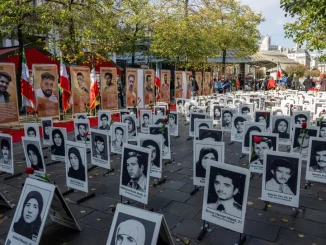
| Published July 28, 2025
In the quiet town of Álamo Temapache, Veracruz, the life of 62-year-old Irma Hernández Cruz reflected the resilience of many working-class Mexicans. A retired schoolteacher who turned to taxi driving to make ends meet, Irma embodied both dignity and determination. But on a July morning in 2025, her daily routine was violently interrupted when masked men abducted her in broad daylight. Days later, a haunting video surfaced—Irma, bound and forced to deliver a cartel’s chilling message to fellow taxi drivers. Her body was found soon after, discarded on a remote ranch. The case of Irma Hernández has since become a national symbol of the growing grip of organized crime and the deadly consequences of refusing to pay extortion. This article explores who she was, what happened to her, and what her story reveals about life under the shadow of cartel terror in modern-day Mexico.
🕯️ Irma Hernández: Teacher‑turned‑taxi‑driver
-
Irma Hernández Cruz, aged 62, was a retired primary school teacher who supplemented her meager pension by driving taxi #554 in Álamo Temapache, Veracruz.
-
On July 18, 2025, she was kidnapped in broad daylight outside the municipal market taxi stand. Armed, masked men dragged her into a van without interference from witnesses—paralyzed by fear.
📹 Coerced Message: A Warning to Others
-
A disturbing video circulated widely: Irma appeared kneeling, hands tied, surrounded by ten masked men. She was forced to deliver a chilling message to other taxi operators:
“Compañeros taxistas, paguen su cuota … con la Mafia Veracruzana no se juega o terminarán como yo”
-
The message reflected the extortion rackets by Mafia Veracruzana—also known as a splinter faction of the Gulf Cartel (Grupo Sombra)—targeting the transport sector in Veracruz, particularly small operators.
⚰️ Discovery and Official Cause of Death
-
July 24, 2025: Her body was recovered on a ranch between the communities of Buenos Aires and Tepetzintlilla, approximately 40 km from the site of the abduction.
-
According to Governor Rocío Nahle and the Governor’s office, the medical examiner ruled her death a heart attack induced by extreme violence during the abduction. Federal forces discovered abandoned weapons and vehicles at the site; there was no ransom demand during the incident.
🚔 Investigation, Arrests & Government Response
-
The Veracruz Attorney General’s Office quickly arrested two suspects: Víctor Manuel “N” (“El Cholo”) and José Eduardo “N”, believed to be associated with the Mafia Veracruzana.
-
Both Veracruz Governor Rocío Nahle and President Claudia Sheinbaum publicly denounced the crime, pledging swift justice and stating firmly: “there will be no impunity”.
-
The national government rolled out its anti-extortion strategy on July 6, 2025, focusing on high-risk states like Veracruz, which together account for 66% of extortion complaints.
🔍 Broader Context: Extortion & Impunity in Veracruz
-
Extortion, or “cobro de piso,” is endemic in communities across Veracruz. In 2025, nearly 7 million Mexicans were victims of extortion, but less than 0.2% formally report it.
-
Presence of criminal groups like the Mafia Veracruzana exacerbates insecurity—many small transport and commercial workers report being forcibly conscripted into paying protection fees. The state appears unable or unwilling to effectively prevent or prosecute these acts in remote and semi‑urban zones.
 Implications:
Implications:
Here are the key implications of Irma Hernández’s case—locally, nationally, and internationally:
🔍 1. Rising Cartel Control Over Civilian Life
Irma’s murder underscores how organized crime groups like Mafia Veracruzana now control not just drug routes, but daily life in places like Veracruz. Cartels no longer limit their violence to rivals—they now enforce extortion payments from taxi drivers, market vendors, teachers, and retirees.
Implication: Everyday citizens are being conscripted into criminal economies—pay or die. This turns public spaces like markets, taxi stands, and even classrooms into extensions of cartel territory.
⚖️ 2. Erosion of Law and State Authority
Irma was kidnapped in public, in broad daylight. No police intervened. The cartel filmed her, released the video, and dumped her body—with no fear of immediate consequences. Arrests came only after national outrage.
Implication: In regions like Álamo Temapache, criminal impunity is the norm, and state presence is reactive, not protective. This undermines faith in the justice system and empowers cartels to act as shadow governments.
💡 3. Extortion as a Growing Threat to the Informal Economy
Irma’s story reveals that extortion is now as common—and deadly—as drug trafficking. Taxi drivers, who operate on thin margins, are routinely targeted. Like her, many victims don’t report threats due to fear or mistrust of police.
Implication: Mexico’s informal economy—which employs over half the population—is under siege. If workers must pay cartels to work, the result is economic instability, forced migration, or worse: mass compliance with organized crime.
📢 4. Impact on National Narrative and Policy
Irma’s coerced message went viral: “With the Mafia Veracruzana you don’t play, or you’ll end up like me.” That line became a public outcry across Mexico. National leaders—like President Claudia Sheinbaum—were forced to respond, announcing federal anti-extortion measures.
Implication: Her death may catalyze more aggressive national policies targeting extortion—but the depth of cartel infiltration means results won’t come quickly. Critics warn these pledges often fade once headlines do.
🌎 5. International Attention on Mexico’s Internal Security Crisis
The imagery—an elderly woman surrounded by masked gunmen—struck a nerve globally. U.S. and European media picked up the story. The case highlights Mexico’s worsening human rights crisis, where civilians are caught between criminal violence and weak institutions.
Implication: Irma’s case may fuel international pressure on Mexico to prioritize internal security, reinforce anti-cartel operations, and protect journalists and community workers documenting such crimes.
💔 6. Symbolism: Irma as a National Martyr
Irma was not just a victim—she became a symbol of resistance. A retired teacher working to survive, refusing to pay extortion, and ultimately dying for it. Her final words, though coerced, told the truth: “this is what happens when you don’t obey.”
Implication: Her story may inspire collective civic action—or deeper fear. How the government handles this case will determine whether Irma is remembered as a turning point, or another name lost to the statistics.
 Overall Takeaway:
Overall Takeaway:
SOURCES: THE GATEWAY HISPANIC – Irma Hernández, Teacher and Taxi Driver, Kidnapped and Murdered After Refusing to Pay Extortion in Veracruz
PARRIVA – How the Cártel Mafia Veracruzana, the group that murdered teacher Irma Hernández, operates





Be the first to comment